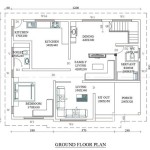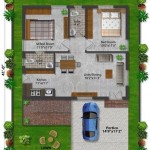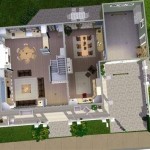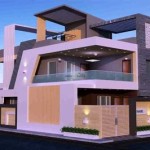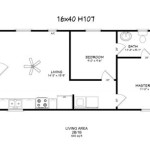House Plans With Sunrooms: Embracing Natural Light and Enhanced Living
House plans with sunrooms represent a popular design choice, catering to homeowners seeking to integrate indoor and outdoor living. These plans offer a dedicated space designed to maximize sunlight exposure and create a comfortable environment throughout the year. A sunroom, also known as a solarium, conservatory, or sun porch, can serve various purposes, acting as a relaxing retreat, a vibrant dining area, a lush greenhouse, or a functional extension of the living space. The appeal of house plans incorporating sunrooms stems from their ability to enhance the aesthetic appeal of a home while also providing practical benefits that improve the overall quality of life for its occupants.
The design and construction of a sunroom require careful consideration of several factors, including the home's architectural style, climate, orientation, and the intended use of the space. Successful integration of a sunroom into a house plan involves selecting appropriate materials, ensuring proper ventilation and climate control, and complying with local building codes and regulations. Different types of sunrooms exist, ranging from simple screened-in porches to fully insulated, climate-controlled additions, each offering unique advantages and catering to specific needs and preferences.
The integration of a sunroom into a house plan often impacts the home's energy efficiency. While maximizing sunlight exposure is a primary goal, it is crucial to implement measures to prevent overheating during the summer months and heat loss during the winter. Strategies such as using energy-efficient windows, installing shading devices, and incorporating proper insulation can help mitigate these issues and maintain a comfortable temperature within the sunroom year-round. Furthermore, the orientation of the sunroom plays a significant role in its energy performance, with south-facing sunrooms generally receiving the most sunlight and requiring careful management to prevent excessive heat gain. Understanding these aspects is vital when choosing house plans with sunrooms.
Key Considerations When Choosing House Plans With Sunrooms
Selecting the right house plan with a sunroom involves a thoughtful assessment of various factors to ensure that the addition complements the existing home and meets the homeowner's specific needs. This process requires careful consideration of the sunroom's size, location, design, and functionality, as well as the overall aesthetic and architectural compatibility with the main house.
Firstly, the size and location of the sunroom must be carefully evaluated. The size should be proportionate to the overall dimensions of the house and should align with the intended use of the space. A small sunroom may suffice for a cozy reading nook, while a larger sunroom may be necessary for a dining area or a family gathering space. The location of the sunroom should be strategically chosen to maximize sunlight exposure while also considering privacy and accessibility. South-facing locations typically receive the most sunlight, but east- or west-facing locations may be preferable depending on the local climate and the homeowner's preferences. The sunroom's location should also provide easy access from the main living areas of the house, facilitating seamless integration and encouraging frequent use.
Secondly, the design and materials of the sunroom should harmonize with the architectural style of the house. The sunroom should appear as a natural extension of the existing structure, rather than an afterthought. This requires careful selection of materials, finishes, and architectural details that complement the overall design aesthetic. For example, a traditional-style house may benefit from a sunroom with a sloped roof, wood framing, and traditional windows, while a modern-style house may lend itself to a sunroom with a flat roof, metal framing, and large expanses of glass. The choice of materials should also consider durability, maintenance requirements, and energy efficiency. Selecting high-quality windows and doors with good insulation can significantly reduce energy costs and improve the comfort of the sunroom.
Thirdly, the functionality of the sunroom should be carefully considered. The intended use of the space will influence its design and layout. For example, a sunroom intended for use as a greenhouse will require specialized features such as ventilation, drainage, and shelving. A sunroom intended for use as a dining area will need adequate space for a table and chairs, as well as appropriate lighting and ventilation. A sunroom intended for use as a living room will require comfortable seating, a television, and other amenities. The layout of the sunroom should be designed to maximize space utilization and create a comfortable and functional environment. Proper planning and design are essential to ensure that the sunroom meets the homeowner's specific needs and enhances their enjoyment of the home.
Sunroom Styles and Design Options
The variety of sunroom styles and design options offers homeowners a wide range of choices to suit their individual preferences and architectural styles. From traditional conservatories to modern glass enclosures, sunrooms can be customized to complement any home and enhance its aesthetic appeal. Understanding the different styles and design options available is crucial for selecting a sunroom that meets the homeowner's specific needs and complements the overall design of the house.
One popular style is the conservatory, which is characterized by its glass roof and walls, creating a greenhouse-like environment. Conservatories are typically used for growing plants or as a relaxing retreat where homeowners can enjoy natural light and views of the surrounding landscape. They often feature ornate architectural details and are reminiscent of Victorian-era greenhouses. Conservatories can be customized with a variety of glazing options, including tinted glass, insulated glass, and self-cleaning glass, to enhance their energy efficiency and reduce maintenance requirements.
Another common style is the sun porch, which is typically a screened-in or glass-enclosed porch that extends from the main house. Sun porches provide a comfortable outdoor living space that is protected from insects, rain, and wind. They are often used for dining, lounging, or entertaining guests. Sun porches can be constructed with a variety of materials, including wood, aluminum, and vinyl, and can be customized with different types of screening or glazing. They offer a cost-effective way to add an outdoor living space to a home without the expense of a fully enclosed sunroom.
A solarium is a type of sunroom that features a glass roof and walls, similar to a conservatory, but with a more contemporary design. Solariums often incorporate clean lines, minimal ornamentation, and large expanses of glass to maximize natural light and views. They are commonly used as living rooms, dining rooms, or home offices. Solariums can be constructed with a variety of materials, including aluminum, steel, and glass, and can be customized with different types of glazing and framing systems. The choice of materials and design elements will depend on the homeowner's style preferences and the overall architectural design of the house.
Beyond these common styles, a wide range of custom sunroom designs exist, allowing homeowners to create a unique and personalized space that reflects their individual tastes. Custom sunrooms can incorporate a variety of features, such as fireplaces, skylights, built-in seating, and water features. They can also be designed to accommodate specific needs, such as growing plants, exercising, or pursuing hobbies. The possibilities are virtually endless, allowing homeowners to create a sunroom that is both functional and aesthetically pleasing.
Maximizing Energy Efficiency in Sunroom Design
Energy efficiency is a crucial consideration in sunroom design, as these spaces are often subject to significant temperature fluctuations due to their large glass surfaces. Implementing strategies to maximize energy efficiency can help reduce heating and cooling costs, improve occupant comfort, and minimize the environmental impact of the sunroom. This requires careful selection of materials, proper insulation, efficient ventilation, and smart shading techniques.
One of the most important factors in energy-efficient sunroom design is the selection of high-performance windows and doors. Energy-efficient windows and doors typically feature multiple panes of glass, low-emissivity (Low-E) coatings, and inert gas fills, such as argon or krypton. These features help to reduce heat transfer through the glass, keeping the sunroom warmer in the winter and cooler in the summer. Low-E coatings reflect infrared radiation, reducing heat gain during the summer and heat loss during the winter. Inert gas fills provide additional insulation by reducing convection currents between the panes of glass. Selecting windows and doors with high energy performance ratings, such as those certified by the National Fenestration Rating Council (NFRC), can significantly improve the energy efficiency of the sunroom.
Proper insulation is also essential for maximizing energy efficiency. Insulation helps to reduce heat transfer through the walls, roof, and floor of the sunroom, keeping the space more comfortable year-round. Different types of insulation are available, including fiberglass batts, spray foam, and rigid foam boards. The choice of insulation will depend on the construction of the sunroom and the homeowner's preferences. It is important to ensure that the insulation is properly installed and sealed to prevent air leaks, which can significantly reduce its effectiveness. Insulating the sunroom's foundation or slab can also help to reduce heat loss through the floor.
Efficient ventilation is crucial for preventing overheating during the summer months. Sunrooms can quickly become excessively hot due to solar heat gain, especially in south-facing locations. Ventilation helps to remove hot air from the sunroom and replace it with cooler air, maintaining a comfortable temperature. Natural ventilation can be achieved through the use of operable windows and vents. Cross-ventilation, where air flows through the sunroom from one side to the other, is particularly effective. Mechanical ventilation, such as ceiling fans or exhaust fans, can also be used to enhance airflow. In some cases, air conditioning may be necessary to provide adequate cooling during periods of extreme heat.
Implementing smart shading techniques can also help to reduce solar heat gain and improve energy efficiency. Shading devices, such as awnings, blinds, curtains, and solar screens, can block sunlight before it enters the sunroom, reducing the amount of heat that is absorbed. Exterior shading devices are generally more effective than interior shading devices, as they block sunlight before it reaches the glass. Deciduous trees and shrubs can also provide natural shading during the summer months, while allowing sunlight to penetrate during the winter. Strategic landscaping can help to create a more comfortable and energy-efficient environment around the sunroom.

House Plans With Sunrooms Or 4 Season Rooms
.webp?strip=all)
One Story Home Plan With Sunroom 4746

House Plans With Sunrooms Or 4 Season Rooms

Craftsman Ranch With Sunroom 89852ah Architectural Designs House Plans

Traditional Style House Plan 4 Beds 3 5 Baths 4759 Sq Ft 54 339 Plans With Pictures How To

House Plans With Solarium Or Sun Room Drummond

House Plans With Solarium Or Sun Room Drummond

Split Bedroom Ranch Design With Sunroom 62024v Architectural Designs House Plans

House Plans With Sunroom Global Solariums

House Plans With Solarium Or Sun Room Drummond




